
By David Eskenazi and Steve Rudman
The Washington-Washington State rivalry presents a marvelous opportunity to play, “Who Knew?” It’s unlikely, for example, that the 59,887 fans who froze throughout the 1985 Apple Cup at Husky Stadium (26 degrees at kickoff) had any inkling that they might be watching a future Super Bowl MVP, a College Football Hall of Famer, and 28 players who would be selected in two subsequent NFL drafts.
Or that the 51,221 who witnessed Washington State’s 27-25 victory in 1951 were seeing a future member of the Pro Football Hall of Fame, a future member of the College Football Hall of Fame and a future Olympic gold medalist in boxing.

Should you care to review the UW-WSU rivalry, you’ll find that it is rich with such arcana. Future NFL head coaches have played in the Apple Cup, and so have future Pro Football Hall of Famers and NFL Players of the Year. The game has also featured future Congressmen and mayors. A look back on some of the game’s more intriguing graffiti:
Pro Champion: Washington’s George Wilson (1923-25) became the first graduate of the Washington-Washington State series to play on a professional football champion, and the rivalry’s first future All-Pro. UW’s first consensus All-American, selected by The Associated Press, Grantland Rice and Collier’s, and a star in two Rose Bowl games (1924, 1926), Wilson barnstormed through a series of exhibition games with Red Grange after his senior year and then signed with the American Football League’s Los Angeles Buccaneers.
When the ill-fated Buccaneers folded after a few months, Wilson joined the NFL’s Providence Steam Roller, an early franchise that played its games in a 10,000-seat velodrome in Providence, RI.
Wilson spent three seasons with the Steam Roller and had his best year in 1928 when the Steam Roller won the NFL title with an 8-2-1 record (no championship game then). Wilson scored five touchdowns that year, a big total, and was named first-team All-Pro by both the Green Bay Press Gazette and Chicago Tribune, two of the major All-Pro selectors of the era.
Wilson performed in the NFL at a time when the best players earned a couple of hundred dollars per game with little hope of making more. At the urging of Providence teammate Gus Sonneberg, who met Wilson in Seattle when Sonneberg’s Dartmouth Hanover Horde helped the University of Washington christen Husky Stadium (Nov. 27, 1920), Wilson was persuaded to join Sonneberg in a new venture, a professional wrestling tour through Australia.
They both cleared $10,000 on the trip, but authorities would not allow them to bring the money into to the United States. Broke and too old to return to pro football, Wilson spent most of his life as a day laborer and dock worker. An Everett native, he entered the College Football Hall of Fame in 1951 and died in San Francisco in 1963.
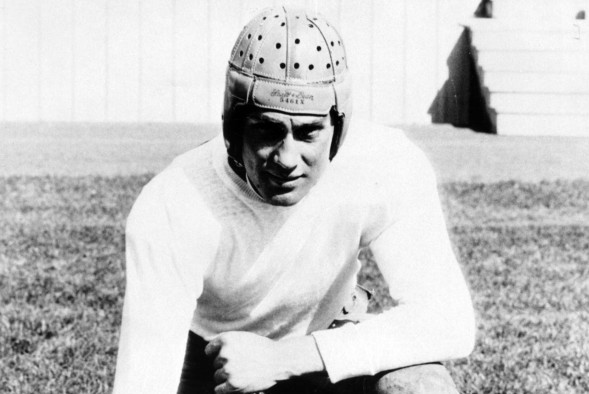
Eye on 1929: The 23rd renewal of the UW-WSU rivalry featured an intriguing cast: Two future NFL Hall of Famers, two future professional head coaches, three future members of the College Football Hall of Fame, a future NFL Most Valuable Player, and the future world record holder in the discus.
Teammates on Washington State’s 1930 Rose Bowl team, Mel Hein and Turk Edwards of WSU more than held up the Cougars’ part of that intriguing cluster.
Hein played both ways throughout his pro career, most of it with the New York Giants, and in 1938 became the first (and still the only) center named NFL Most Valuable Player. When he retired, Hein coached the 1947 Los Angeles Dons and served as a line coach for several teams, including the New York Yankees and Los Angeles Rams. After spending 15 seasons as a USC assistant line coach, Hein went into private business. He entered the College Football Hall of Fame in 1954 and was part of the Pro Football Hall of Fame’s inaugural class in 1963.
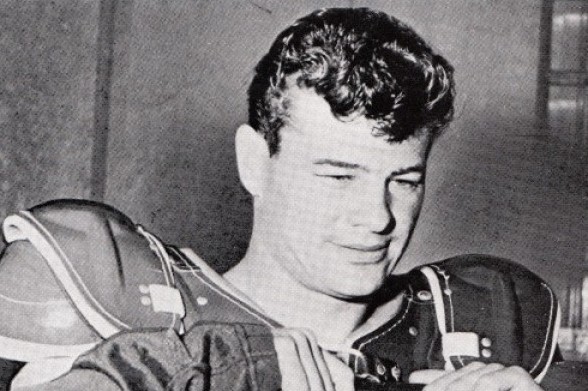
A three-time All-Pro and a member of the NFL’s All-Decade Team for the 1930s, Edwards played for the Boston/Washington Redskins from 1932-40 and coached the franchise from 1946-48. He made the Pro Football Hall of Fame in 1969 and the College Football Hall of Fame in 1975.
Washington’s Paul Schwegler, a two-time All-America tackle from 1929-31, entered the College Football Hall of Fame in 1967; Paul Jessup, a tackle for Washington from 1927-29, set a world record in the discus (169-9) Aug. 23, 1930 at the AAU Track and Field Championships in Pittsburgh, shortly after his UW graduation.
Led by Hein and Edwards, the Cougars won their 1929 meeting with the Huskies 20-13.

First No. 1 picks: Ed Goddard (WSU, 1937), Rudy Mucha (UW, 1941) and Dean McAdams (UW, 1941) became the first players from the rivalry to go in the first round of the NFL draft.
A three-time All-America first-team quarterback (1934-36), Goddard went to the Brooklyn Dodgers in the first round in 1937, second overall behind Nebraska’s Sam Francis. Goddard played two years, starting seven games.
In hindsight, the Dodgers would have been better served taking Texas Christian’s Sammy Baugh, the sixth overall pick in 1937 who went to the Washington Redskins. Baugh became the Peyton Manning of his day, earning six Pro Bowl nominations, and was enshrined in the Hall of Fame in 1963.
A center who came to the Huskies from Chicago, Mucha was the fourth overall pick in 1941 by the Cleveland Rams and had a 22-game career that ended in 1946. Washington teammate McAdams went to the Brooklyn Dodgers with the eighth overall pick and played 30 games over three seasons. Mucha and McAdams were the first two ex-Huskies selected among the top 10 picks in the draft.
Strangest injury: Glen “Turk” Edwards and Mel Hein, Washington State teammates in 1929-30, both went on to play pro football, Edwards with the Boston Braves and Washington Redskins, Hein with the New York Giants. On Nov. 24, 1940, Edwards and Hein, the respective captains of the Redskins and Giants, met at the center of the field for the pre-game coin toss. When Edwards turned to go back to the Washington bench, his knee collapsed. He never played again.

Last bows: The 1951 Apple Cup was the last collegiate contest for a future Pro Bowl Most Valuable Player (UW’s Hugh McElhenny, 1958) and future Olympic boxing gold medalist Pete Rademacher of WSU, who won the light-heavyweight crown in 1956.
McElhenny, named Washington’s greatest player in the second half of the 20th century on the occasion of the school’s Centennial in 1989, joined the San Francisco 49ers as the draft’s ninth overall pick in 1952. He scored 60 touchdowns in his career, was part of the 1950s All-Decade team and won the Pro Bowl MVP award in 1958.
A WSU lineman, Rademacher never played football professionally, choosing a career in boxing. Between 1952-55, Rademacher won numerous amateur titles, including the Seattle Gold Gloves four times, the U.S. Amateur Championships, the Chicago Gold Gloves and All-Army Championship. The latter triumph landed him on the 1956 U.S. Olympic team, and the gold medal he won in the heavyweight division greased his chance to fight for the world title in his first pro bout.
Rademacher couldn’t dethrone heavyweight champion Floyd Patterson, but knocked Patterson down twice at Sick’s Stadium Aug. 22, 1957.

Apple Cup cluster: The 1985 Apple Cup, played in a frigid Husky Stadium, featured a future Super Bowl Most Valuable Player, three future No. 1 NFL draft choices, a future NFL scoring leader, the winner of two future Super Bowl rings, a College Football Hall of Famer, the only player named MVP of the Rose and Orange bowls, and the father of a three-time NBA Slam Dunk champion.
Quarterback Mark Rypien of Washington State, who led the Cougars to a 21-20 victory in that 1985 game, directed the Washington Redskins to victory in Super Bowl XXVI, becoming the first native of Canada (Calgary, Alberta) selected MVP on football’s biggest stage.
Washington sported the three No. 1 picks, DT Ron Holmes (1985 Tampa Bay), LB Joe Kelly (1986 Cincinnati) and DE Reggie Rogers (1987 Detroit), as well as kicker Jeff Jaeger, who led the NFL in scoring in 1993 as a member of the L.A. Raiders.
Washington’s Kevin Gogan won two Super Bowl rings as a member of the Dallas Cowboys (1992-93), Washington State’s Rueben Mayes entered the College Football Hall of Fame in 2009, and Washington RB Jacque Robinson, the Rose-Orange MVP, not only starred in three Apple Cups for the Huskies (1982-84), so did son Nate as a defensive back in 2002, after which Nate Robinson won the NBA dunk contest three times.

The 1985 Apple Cup included 28 players between the schools who were selected in NFL drafts.
Accolades: In 1999, the editors of Total Football, in cooperation with the Pro Football Hall of Fame, selected the “300 Greatest Players in Pro Football History.” Among the 300 were six Apple Cup graduates – three Huskies and three Cougars.
From Washington: Arnie Weinmeister (1942, ’46-47), Hugh McElhenny (1949-51) and Warren Moon (1975-77), now all members of the Pro Football Hall of Fame. From Washington State: Mel Hein (1928-30), Turk Edwards (1929-31) and Drew Bledsoe (1990-92). Hein and Edwards are enshrined in Canton and Bledsoe has received numerous nominations.
Pro Bowl MVPs: Mark Brunell (1997) and Warren Moon (1998) of Washington, who played in a combined five Apple Cups, were named Most Valuable Players in the AFC-NFC Pro Bowl in back-to-back years.
Brunell, who set five Rose Bowl passing records in 1991, was selected Pro Bowl MVP in 1997 as a member of the Jacksonville Jaguars. Moon, as a member of the Seahawks, won it the following year after scoring the game-winning touchdown.
Four Pro Bowl quarterbacks: The 1998 Pro Bowl, in which Moon was voted MVP, featured four ex-Apple Cup quarterbacks. In addition to Brunell and Moon, Washington’s Chris Chandler represented the Atlanta Falcons and Washington State’s Drew Bledsoe represented the New England Patriots.
In addition to Moon’s game-winning TD, Brunell threw a 17-yard TD pass to Andre Rison and Bledsoe tossed a 14-yard TD pass to Jimmy Smith. Chandler had the misfortune of fumbling the ball over to the AFC late the game, setting up Moon’s one-yard TD run.
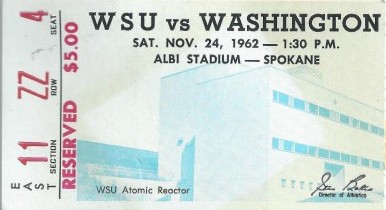
Five In Canton: Five who participated in the UW-WSU rivalry are in the Pro Football Hall of Fame. Washington’s inductees: Hugh McElhenny (1970), Arnie Weinmeister (1984) and Warren Moon (2006). Washington State’s inductees: Mel Hein (1963) and Turk Edwards (1969).
UW players To head coach: Enoch Bagshaw, who earned five football letters playing for Washington from 1903-07, was the first former UW player to become head coach at the school when he began a nine-year run in 1921. John Cherberg (1930-32) and Jim Lambright (1963-64) are the only other former UW players to become head coaches of the Huskies. Cherberg coached UW from 1953-55 and Lambright from 1993-98.
WSU players to head coach: Emory Alvord (1913-14), who coached the Cougars in 1918, Phil Sarboe (1931-33), the head man from 1945-49, and Paulf Wulff (2008-11), are the only former Cougar players to run the football program at WSU. Wulff compiled a 9-40 record in his four seasons.
UW-WSU head coaches to pro head coach: Three who served as head coaches in the UW-WSU series became professional head coaches. Lone Star Dietz, WSU’s head coach from 1915-17, coached the Boston Braves in 1933-34. Dennis Erickson (1987-88) coached the Seattle Seahawks from 1995-98 and the San Francisco 49ers in 2003. Jimmy Phelan, Washington’s coach from 1930-41, coached the Los Angeles Dons in 1948-49 and the Dallas Texans in 1952.

UW-WSU assistants to pro head coach: Jim Mora the elder, an assistant under Don James at Washington from 1976-78, became head coach of the New Orleans Saints (1986-96) and Indianapolis Colts (1998-01).
UW-WSU players to pro head coach: In addition to the pro coaching stints by Mel Hein and Turk Edwards, WSU’s Harland Svare (1950-52) coached the L.A. Rams (1960-62) and San Diego Chargers (1971-73), and Hugh Campbell (1960-62) coached the Edmonton Eskimos to five consecutive CFL titles before taking over the Houston Oilers (1984-85).
Don Coryell, a 1949 UW letterman, and Jim Mora the younger (1981-83), served as head coaches in the NFL. Coryell directed the St. Louis Cardinals from 1973-77 and San Diego Chargers from 1978-86. Mora directed Atlanta from 2004-06 and Seattle in 2009. Mora is the current head coach of the UCLA Bruins.
Crossing Over: Two UW assistant coaches became WSU head coaches. Jim Sutherland, a UW assistant under Johnny Cherberg (1953-55), served as head coach of the Cougars from 1956-63. Bert Clark, an assistant under Jim Owens (1957-74), coached the Cougars from 1964-67. Neither Sutherland nor Clark produced more than one winning season at WSU. Sutherland compiled a 2-6 record against the Huskies, Clark a 1-3 mark.
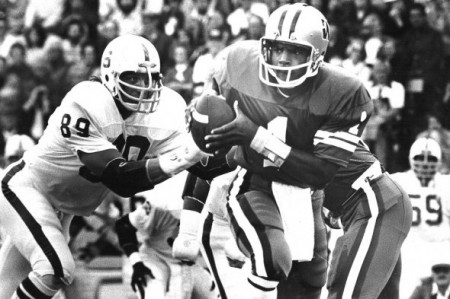
Hall of Fame coaches: Seven men who coached in the Apple Cup eventually made the College Football Hall of Fame. From Washington: Gil Dobie (1951), Jimmy Phelan (1973), Darrell Royal (1983) and Don James (1997). From WSU: Babe Hollingbery (1979), Forest Evashevski (2000), Lone Star Dietz (2012).
Dobie, who coached at Washington from 1908-16, could have faced Dietz in both the 1915-16 seasons, but UW and WSU didn’t play each other in either year. Phelan, Washington’s coach from 1930-41, went head-to-head against Hollingbery 11 times and compiled a 6-2-3 record.
Fathers & sons: Tuffy Ellingsen’s punting factored greatly in Washington State’s 3-0 victory in 1930. In 1957, Don Ellingsen, Tuffy’s son, caught eight passes for 82 yards and a TD in WSU’s 27-7 victory. UW tackle Mac Bledsoe played in three consecutive Apple Cups (1965-66-67) for the Huskies. His son, Drew, played in three in a row (1990-92) for the Cougars. Jacque Robinson produced a pair of 100-yard rushing games for Washington between 1981-84, and son Nate made a key interception in Washington’s 29-26 three-overtime win in 2002.
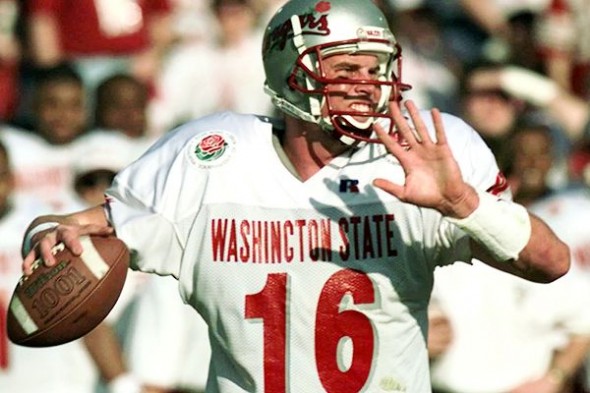
Brother vs. brother: The 1990 Apple Cup matched Washington placekicker Jason Hanson against his brother, Husky placekicker Travis. Travis kicked a 42-yard field goal and five extra points in Washington’s 55-10 victory at Martin Stadium. Jason booted a 46-yard field goal and kicked an extra point for the Cougars.
First to play for UW & WSU: Frank Field became the first player in the history of the rivalry to play for both Washington and Washington State. Field lettered at WSU in 1897 and at Washington in 1899 and 1900.
“Couskies”: Nine played for both Washington and Washington State in the Apple Cup. All, except the aforementioned Frank Field at the turn of the 20th century, switched schools during the World War II years when the Navy and Marines transferred students so they could participate in the equivalent of officer candidate training.
The nine “Couskies:” Frank Field (1899-00, UWd and 1897 (WSU); Al Akins (1943, UW and 1942, ’46-47, WSU); Hal Anderson (1946-47, UW and 1942 WSU); Tag Christensen (1943, UW and 1942, ‘47, WSU); Wally Kramer 1943 (UW and 1942, ’46, WSU); Vern Oliver (1943, UW and 1942, WSU); Jay Stoves (1943, UW and 1940-42, WSU); Jim Thompson (1946, UW and 1942, WSU); Bill Ward (1943, UW and 1941-42 WSU).
————————————
Many of the historic images published on Sportspress Northwest are provided by resident Northwest sports history aficionado David Eskenazi. Check out David’s Wayback Machine Archive. David can be reached at (206) 441-1900, or at seattlesportshistory@gmail.com

2 Comments
Go Cougs!
Great story, guys. Boy, do I remember that 1985 Apple Cup…mostly because the snowstorm two days before meant walking from work in downtown Seattle to the apartment I was subletting at East Lake Union due to my car not being able to move an inch from its parking space. And was it ever COLD!!!
And, yes…GO COUGS!